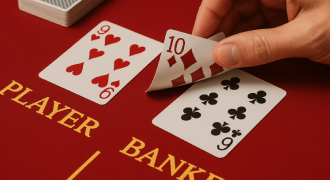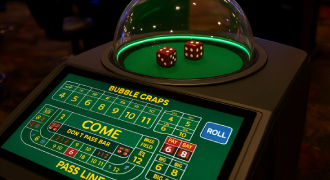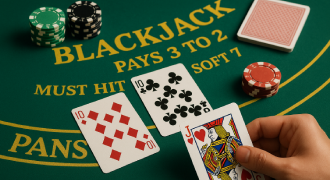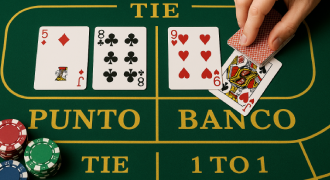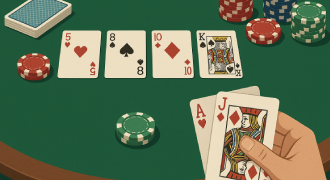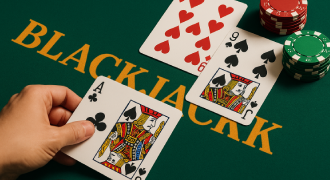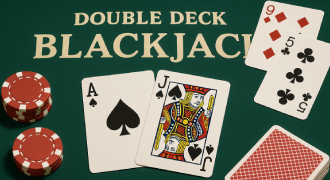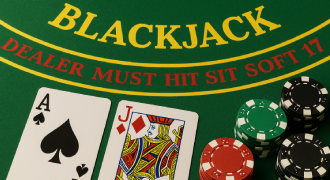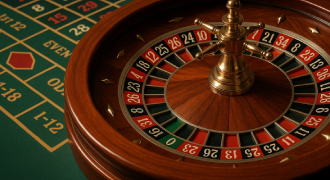Three Card Poker Explained: Rules, Hands, and Strategy
Here is a clear, step-by-step introduction to a fast casino classic that blends simple rules with brisk decision-making. You’ll learn table flow, payouts, and the logic behind optimal choices, so your first session feels structured rather than chaotic. The format is compact, the math is approachable, and the rhythm rewards players who can evaluate rank, suit, and position in seconds. For context and consistency, this guide references the standard casino version of three card poker with optional side bets and a dealer-qualification mechanic that shapes risk and reward.
What is Three Card Poker and How It Works
This is a heads-up game against the house where you start with an Ante and optionally a Pair Plus wager, receive three cards, and then decide to play or fold. The dealer flips three cards, checks for a qualifying hand, and then resolves pay or push outcomes based on comparison and posted schedules. The decision tree is compact, which means you can learn the flow quickly and focus on the key threshold at which calling is profitable and folding is prudent.
Most venues follow a shared core of three card poker rules that cover dealing, dealer qualification, and settlement sequences. If you prefer real-time dealing via streaming, many platforms offer online three card poker with live croupiers and synchronized bets that mirror the felt experience.
Cheat sheet for Three Card Poker with the main stages, hands, and tips 🎰🃏
|
🔑 Aspect |
📖 Explanation |
|
🎯 Goal |
Beat the dealer with a stronger 3-card hand |
|
💵 Bets |
Ante (mandatory), Pair Plus (optional), Play (if you continue) |
|
🃏 Dealing |
Player and dealer each get 3 cards (face down for player, dealer reveals after) |
|
👔 Dealer Qualification |
Dealer must have Queen high or better to play; otherwise Ante pays even, Play pushes |
|
🏆 Hand Rankings |
Straight Flush > Three of a Kind > Straight > Flush > Pair > High Card |
|
📈 Strategy Tip |
Always play (raise) with Queen-6-4 or better; fold weaker |
|
🎁 Side Bets |
Pair Plus pays based on your hand (e.g., flush, straight, trips) regardless of dealer’s cards |
|
🌐 Online Play |
Available with live dealers; same rules as casino tables |
Basic Rules and Hand Rankings
The game’s backbone is a short ranking ladder that differs slightly from five-card poker because probabilities shift with fewer cards. Straights outrank flushes in this format, and the dealer usually needs Queen-high or better to qualify. Keep your thresholds simple at first and aim to recognize playable holdings without second-guessing.
A quick reference to three card poker hands helps you identify when a medium-high hand is good enough to continue and when it becomes a fold that saves a bet. If you want an anchor phrase to recall hierarchy under time pressure, repeat the sequence aloud during practice until it becomes automatic. You can also memorize a condensed chart that marks the promotion points where your equity exceeds the call threshold in three card poker.
Pair, Flush, Straight, Three of a Kind
From strongest to weakest in three card poker: three of a kind, straight, flush, pair, and high card. This inversion versus five-card poker results from how often each combination appears with only three cards. The change matters because it moves the value line and shapes which borderline hands become profitable calls.
Ranking Hands in Three Card Format
Because only three cards are used, the gap in value between adjacent categories is sharper than in community-card games. That means precise thresholds matter, especially when dealer qualification influences whether you receive an even-money settlement or a push. Knowing the posted three card poker odds for each outcome helps you calibrate expectations over a large sample of hands.
Step-by-Step Guide to Playing a Hand
Understanding the flow removes anxiety and frees your attention for the one crucial decision each round. The sequence is Ante (and optional Pair Plus), deal three cards to the player, choose play or fold, expose the dealer’s three, check qualification, and then resolve bets according to the layout. Once you’ve rehearsed the timing, you can study edge cases such as borderline highs and the effect of suits on flush potential.
If you want the quickest on-ramp, a concise tutorial that explains how to play three card poker will get you to the table in minutes. You can then reinforce muscle memory by playing three card poker in short sessions where you pause after tough decisions and review your logic.
Placing the Ante or Pair Plus Bet
The Ante is your main wager against the dealer. The Pair Plus is a side bet that pays when your holding reaches a listed threshold, whether or not the dealer qualifies. Many players separate their stacks physically to avoid confusion between base and side bets.
Receiving Cards and Decision to Play or Fold
Once you see your three, evaluate rank and structure immediately. High unpaired hands with a strong kicker often sit near the boundary, while pairs and better are easy plays. If your layout uses a printed guide on the felt, compare your holding to that boundary, then act decisively to maintain pace and clarity.
Dealer Qualification and Payouts
Most tables require the dealer to show Queen-high or better to qualify. If the dealer fails to qualify after you commit your Play bet, the Ante may pay even money and the Play could push, depending on house rules. When the dealer qualifies, the comparison determines the settlement, with posted tables for main and bonus outcomes handling exact amounts.
Side Bets: Pair Plus and Ante Bonus
Side wagers add flavor and variance. Pair Plus pays on pairs and above, regardless of the dealer’s result. The Ante Bonus awards extra returns for premium holdings on the main line even before head-to-head comparison. Because side bets carry higher volatility, bankroll management and personal risk tolerance should guide your use of them.
Layouts may vary slightly by house, but the intent is the same: a clean three card poker table that separates base wagers from optional side commitments. For product updates, some enthusiasts skim three card poker news to track new pay schedules or promotional tweaks that appear at major venues.
Payouts and Odds
Pay schedules are printed at the layout, and slight differences change long-run return. You’ll often see premium multipliers on straights, flushes, and trips in Pair Plus, along with fixed bonuses tied to the Ante line. When in doubt, check the signboard for three card poker payouts, so your expectations match the posted table.
Evaluating Risk vs Reward
Side bets introduce higher variance, which can swing sessions quickly. If your goal is smooth bankroll movement, keep side wagers small relative to the Ante. If you are entertainment-focused, set a clear cap before the shoe begins and stick to it regardless of short-term streaks. Smart caps protect the fun and keep you at the table longer.
Strategy Tips for Three Card Poker
The beauty of this game is that optimal decisions reduce to a crisp rule set. Many players memorize a simple boundary that says to play Queen-Six-Four or better and to fold weaker holdings, though you should confirm the exact threshold for your house rules. Pairs and above are automatic continues, while low-queen or jack-high holdings without structure often drop below the line.
Post a minimal plan beside your chips so you never improvise under pressure. Keep your focus on the single yes/no choice rather than storytelling lines from community-card poker. If you practice a compact three card poker strategy, your session decisions become consistent and your variance aligns with the math. For quick recall during live play, summarize the rules in one sentence about your go/no-go threshold for three card poker and repeat it before the deal.
Try Playing Three Card Poker Today
You can test low-stress practice modes or step into live-dealt streams with small limits. If you want fewer distractions, pick a quiet table and observe a few orbits before you post an Ante. Track result types rather than just wins and losses so you see how your threshold rule performs over time. When you’re ready to engage, it’s easy to play three card poker in short sessions that sharpen recognition and confidence. Many platforms now offer three card poker online with clear lobbies, posted returns, and responsible gaming tools.
|
🎰 Provider |
🎯 Paylines |
🔖 Symbols That Pay |
🎲 RTP |
💵 Min Bet |
🎁 Welcome Offer |
|
👑 TriSuit Labs |
20 |
A, K, Q, J, 10, 👑 Wild Crown |
97.1% |
$0.10 |
100% up to $400 + 40 free spins |
|
🃏 Decksmith Gaming |
10 |
Royal Crest, ⭐ Scatter Star, ♠️ Lucky Ace |
96.6% |
$0.20 |
150% up to $300 on first deposit |
|
💎 Prime Reel Co. |
25 |
Gem Suits, 🃏 Wild Joker, 🎖️ Bonus Badge |
97.8% |
$0.05 |
50% up to $250 + 25 free spins |
|
🌌 Aurora Cards |
15 |
Suited Shields, 👑 Scatter Crown, 🅰️ Ace Icon |
96.9% |
$0.25 |
100% up to $150 on signup |
RTP, expressed as a percentage, describes long-run theoretical return. For example, 97.8% indicates an expected $97.80 back for each $100 wagered across a very large sample of rounds. Short sessions can swing above or below that figure due to volatility and hit frequency. Minimum bets such as $0.05, $0.10, $0.20, and $0.25 help you pace your bankroll while you learn feature cadence and variance profiles.
FAQ
Is Three Card Poker a game of skill or luck?
Both matter, but decisions revolve around a simple threshold that can be learned quickly. Once you internalize the boundary, results mostly reflect shuffles and the distribution of premium holdings over time.
What are the best starting hands?
Trips and straights are premium, strong flushes are excellent, and high unpaired holdings near the optimal boundary are playable. Pairs are automatic continues, while weak offsuit lows are routine folds.
Can I bluff in Three Card Poker?
There is no classic bluffing against other players because the game pits you against a fixed procedure and the house. Your edge comes from consistent application of the calling threshold and disciplined side-bet sizing.
Odds of getting a straight?
Straights occur more frequently than flushes in this format, which is why the ranking is inverted compared to five-card poker. Exact percentages vary by house sheet, but you can memorize the approximate frequency to set expectations for a long session.
Can Three Card Poker be played live online?
Yes, many studios stream real tables with professional dealers. You place wagers through an interface that mirrors felt positions and resolves outcomes through synchronized procedures for clarity and speed.

